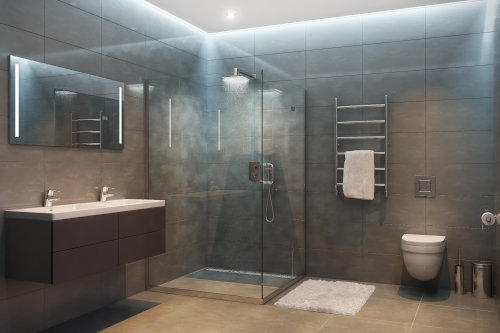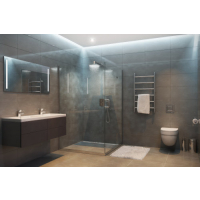What are the Most Eco-Friendly Heated Towel Rails?

Heated towel rails are growing in popularity. This added home comfort was once associated with more upmarket properties and the finer ways of living, but the invention is now more accessible than ever to homeowners.
Elsewhere, popularity toward greener living is also growing. People want luxury and practicality, without leaving a damaging carbon footprint. Fortunately, design is continuously improving to match greener lifestyles, with most modern towel rails created with energy saving technologies.
A heated towel rail may not be an essential, but it can save energy in some ways. With the right knowledge, consumers can make more informed choices and shop more energy conscious.
In this post, we discuss the most eco-friendly heated towel rails available on the market. So, if it’s something you’ve had doubts about for a while, we hope to shed some light on the topic.
Why do we use heated towel rails?
Heated towel rails are the practical alternative to drying towels on radiators, washing lines and door hooks. Towels left out to dry in multiple places around the house can take time, allowing bacteria to grow as well as a musty smell. Damp and wet towels can take hours to fully dry, especially in colder climates.
A heated towel rail eradicates this problem by removing moisture from towels fast and efficiently so that they stay fresh for longer between washes. They’re cheaper and more energy efficient than the tumble dryer, which is renowned for consuming energy and racking up bills.
The quick removal of moisture means you’re less inclined to wash them excessively, saving on energy sources for using the washing machine. The coziness of a warm towel after bathing is the added bonus.
Electric vs Central Heating (hydronic)
If you’re thinking of investing in a heated towel rail for your bathroom, laundry room or even the kitchen, the first thing to understand is the difference between electric rails and rails powered by central heating systems (most commonly found in Europe).
A towel rail powered by the central heating system requires gas which burns, and in turn heats up the water supply. Turning on this system will also turn on the other heat appliances like radiators throughout the house. An electric towel rail is powered on and works independently from the rest of the house.
Electric towel rails
Electric towel rails are the friendlier choice for cutting down energy waste. As an electrical rail operates independently from home heating systems, it can be switched on solely for the purpose of drying or warming up towels, without heating the entire property. This means energy sources are not wasted on an empty home, or in the summertime when central heating is definitely not required.
In warmer months, it’s still important to dry towels thoroughly for hygiene purposes. The electric rail can be powered up and switched back off once it’s done its job.
When and how often the towel rail heats is entirely at your discretion. Use it as little or as often as you need to get those towels fluffed back to life.
Towel rails with a thermostat
A thermostat is a technical device which regulates temperature and keeps it continuously flowing for the desired purpose.
A towel rail with a thermostat is a good eco-friendly choice. Thermostats on electric towel rails are extremely rare, however if you have a towel rail connected to a central heating system (most common in Europe) then it is usally possible for a thermostat to be added.
Where available, thermostats can control and maintain room temperatures with great precision. These devices often come with an eco-mode to maintain good energy levels as much as possible.
Towel rails with timers
Timers are an energy saving essential when it comes to heating a towel rail. There’s no reason why a towel rail should heat continuously, as towels can be dried within a matter of hours or less. With a digital timer, you can take full control over when the rail is active.
Consider your lifestyle and when it makes the most sense to turn on the towel rail. This way, the rail is not heated unnecessarily, especially if you are out of the house all day or going away for the weekend. It can be timed to switch off without you having to be there.
Once you know how long your towels take to dry, or if you have a daily shower routine and you want a hot towel, the timer is in your hands to ensure it is only powered when necessary. Even taking these thoughts into consideration is a more energy conscious way to live.
Dry heating element
Many electric towel rails benefit from using a dry heat element, as opposed to heating up liquid. This is common for modern electric rails and is an increasingly popular choice to save energy. It focuses solely on keeping towels warm, rather than warming up the room itself. Our range of Radiant Heated Towel rails all use a dry electric element.
A purposefully sized towel rail
Towel rails come in an extensive range of sizes, and getting the right one to fit your space is another energy saving solution. The larger the rail or the more bars, the more energy it requires to heat.
A family home will require more towel space, whereas a person living alone and drying off one towel at a time is not the most practical solution. Make sure your towel rail is purposeful for both the size of your space, and your lifestyle.
In summary
Most people are looking toward more sustainable ways of living, from dietary changes, fashion choices and plastic reduction. Home appliances are no different. Opting for more environmentally friendly products is another step away from those that gobble up energy and damage the planet.
Ultimately, there are many variables to finding the right heated towel rail. Overall, electric towel rails are the most eco-friendly and efficient choice. Going in with an energy conscious attitude is key to finding the greenest product on the market.
If you are already the owner of a heated towel rail and you wish to make it more eco-friendly, fitting a thermostat or timer is a great way to take control and avoid excessive energy consumption.
Manufacturers are always looking to improve ways of saving energy through products, and more conscious versions can be found in a range of styles, from ladder rails, single bar and free standing rails.
FAQs
What is the purpose of a heated towel rail?
Heated towel rails are used to dry and warm towels throughout the year. The ability of a heated towel rail to dry towels quickly keeps them fresh for longer by reducing the growth of bacteria and ultimately the need to wash towels so often..
Are electric towel rails energy efficient?
Electric towel rails are the more energy efficient choice when compared with towel rails powered by central heating systems (as they are in Europe). This allows for the towel rail to heat without wasting energy to heat the rest of the home unnecessarily.
Should heated towel rails be left on?
While it is generally safe to leave a heated towel rail running, this is not an eco-friendly choice to make. Controlling your heated towel rail using a digital timer switch and only using it when necessary is the best way to save energy.


